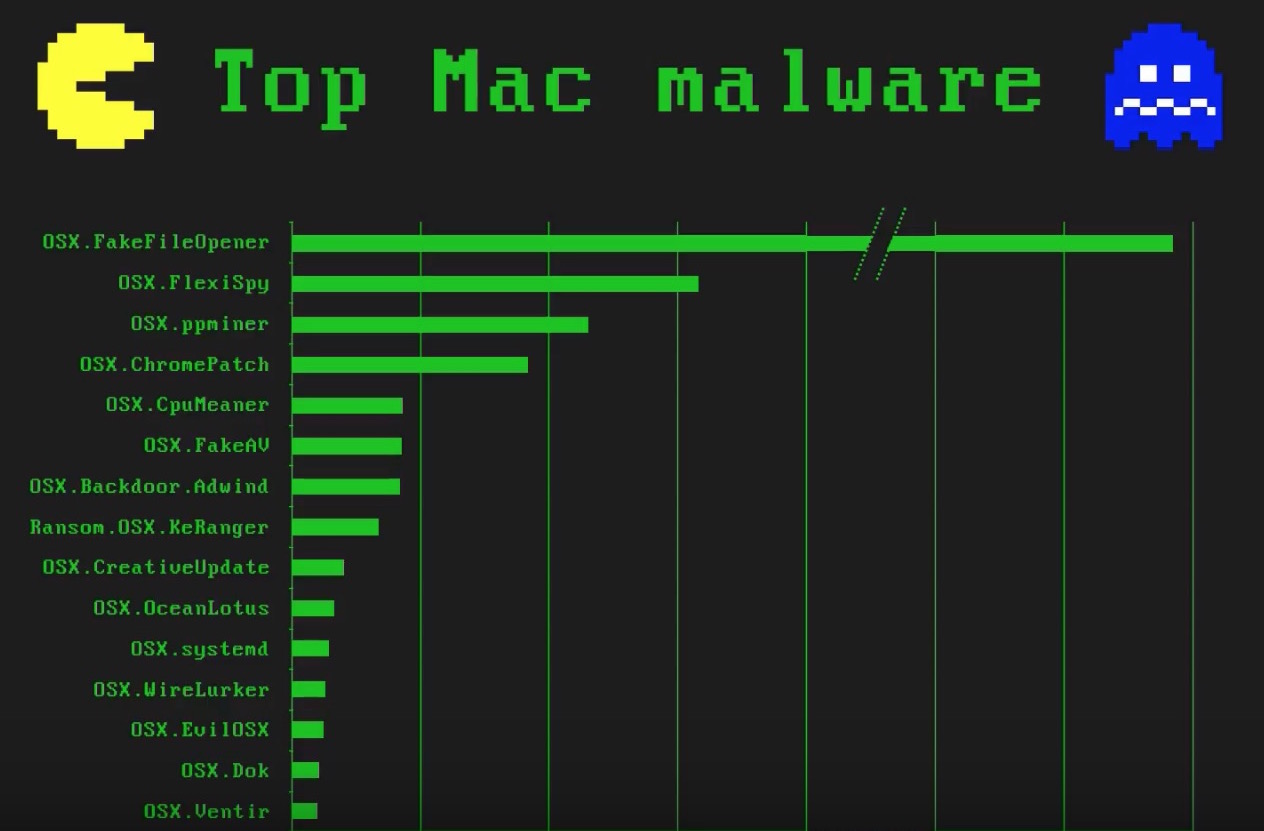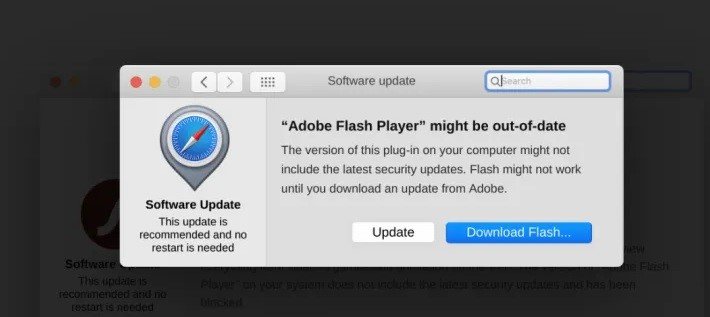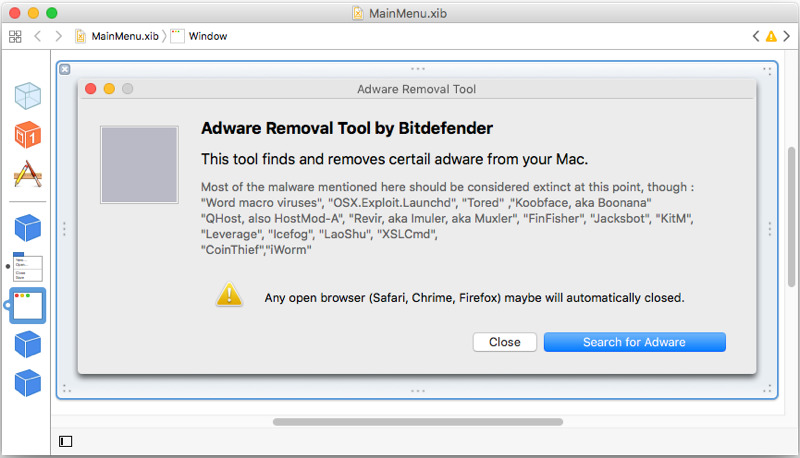macOS usually does a pretty good job of protecting against malware (usually adware), and when one slips through the cracks, anti-malware apps like Malwarebytes do a good job of removing it.
- Flash Player Malware Removal Mac
- I Download Fake Flash Malware On Mac Computer
- Free Malware For Mac
- Malware On Mac Os
Try downloading this program which was written by Thomas R, a long time poster. The program will search for malware/adware The program will do the work for you which makes it easy. It may be necessary to run more than one scan. After running the scans, restart the computer. Malwarebytes Anti-Malware for Mac 10.10 and later. Malwarebytes uninstall. PUP.Optional.FakeFlash is Malwarebytes' generic detection name for a large family of browser extensions that are installed by websites offering fake Flash updates.
However, occasionally a really nasty piece of code comes around, and proves tough to get out of your Mac’s system. Malwarebytes’ blog (via 9to5) warns of a new version of Crossrider adware that has a new way to prevent itself from being removed. Surprise, surprise, it poses as a Flash Player installer to plant itself on your system.
A new variant of the Crossrider adware has been spotted that is infecting Macs in a unique way. For the most part, this variant is still quite ordinary, doing some of the same old things that we’ve been seeing for years in Mac adware. However, the use of a configuration profile introduces a unique new method for maintaining persistence.

Persistence is the goal of most malware. After all, what good is it to infect a machine if the malware stops running as soon as the computer restarts? There are some cases where that can still be useful (ransomware, for example), but in most cases, that’s not desired behavior. So malware creators are often stuck using the same old methods of persistence that are easy to spot. Sometimes, though, they get creative.
To protect itself, the malware changes your homepage in both the Safari and Chrome browsers, and it doesn’t allow you to change it back or to another page.
After removing Advanced Mac Cleaner, and removing all the various components of Crossrider that have been littered around the system, there’s still a problem. Safari’s homepage setting is still locked to a Crossrider-related domain, and cannot be changed.
It turns out that this is caused by a configuration profile installed on the system by the adware. Configuration profiles provide a means for IT admins in businesses to control the behavior of their Macs. These profiles can configure a Mac to do many different things, some of which are not otherwise possible.
In the case of this Crossrider variant, the configuration profile that is installed forces both Safari and Chrome to always open to a page on chumsearch[dot]com. This also prevents the user from changing that behavior in the browser’s settings.
It proves tough to track down on your system profiles and delete.
This profile installs with an identifier of com.myshopcoupon.www, which is not visible in System Preferences. However, the profile can definitely be identified by scrolling through the details and looking for references to chumsearch[dot]com.
When you’ve finally found it, you can delete it and restart your Mac and then change your homepage back.
The Malware blog offers step-by-step details on how to remove this bit of trash.
Viruses are getting smarter these days. One of the common tactics by which malicious software infects computers is through phishing. The attacker makes a bogus link seem legitimate, but it will redirect you to a different page where you will get malicious software installed on your system.
Mac users think that macOS is invincible and does not get infected by malware or viruses. However, recent attacks prove that macOS is just as vulnerable to malicious software as any other operating system. There are even viruses that were designed to target Macs and other Apple devices.
Recently, Mac users reported several cases of getting the Adobe Flash Player virus on Mac. When they go to certain websites, Adobe Flash Player keeps asking to update on Mac even though the system is updated.
What Is the ‘Flash Player Update REQUIRED’ Virus on Mac?
The Adobe Flash Player is a commonly used program that is trusted by most users. Websites use this software to deliver content to the readers, so it is common to see a notification saying that the website needs Flash Player for the page to load.
The Adobe Flash Player virus on Mac takes advantage of this and prompts web visitors of specific websites to update their Flash Player software. This trickery is less obvious compared to asking to install it on their computer because users are now wary of installing software from unknown sources.
Here are some versions of the update notification:
- Update to the latest version of Flash Player. Your current Adobe Flash Player version is out of date.
- WARNING! Your Flash Player is out of date. Please install update to continue.
- “Adobe Flash Player” is out of date.
To continue using “Adobe Flash Player”, download an updated version.
Once you click the link on the notification or the Update button, a DMG file gets downloaded on your computer. Installing that “update” allows the virus to get into your system.
What Happens When You Get the Adobe Flash Player Virus on Mac?
Impersonating Adobe Flash Player is only one of the ways through which attackers infiltrate your system. The type of virus embedded in the downloaded “update” and the effects of the virus on your system depend on the attacker.
Some attackers embed a Trojan virus to steal data or create a backdoor to your system. Others use ransomware to take your personal data and computer hostage and demand payment for their release.
But according to user reports, the most common consequences of the Adobe Flash Player virus on Mac are performance issues. Users noted that there is obvious sluggishness after installing the update and some apps crash or hang for no apparent reason.
This might be because crypto-mining malware has infected the system through the installed “Adobe Flash Player update.” Crypto miners eat up a huge chunk of your computer’s resources, causing your processes to slow down or crash even though you’re not doing anything resource-heavy.
Another common malware type disguised by the Adobe Flash Player virus is adware. You’ll notice that after downloading and installing the “update,” irrelevant and pesky ads start to pop up on your screen all of a sudden. These ads can’t be blocked by ad blockers and are so invasive that they don’t disappear even when you close the browser.
Worse, some ads are not limited to the browser. Some start appearing on apps and other programs running on the infected computer. Restarting the app and the computer doesn’t work. You need to get rid of the adware completely for these ads to disappear.
Flash Player Malware Removal Mac

However, getting rid of the Adobe Flash Player virus on Mac is easier said than done. It is one of the most annoying viruses today because it is so persistent and hard to remove. So if you’re one of those who got tricked by the Adobe Flash Player virus on Mac, follow our virus removal guide below.
How to Remove “Flash Player Update REQUIRED” Virus on Mac
Here’s a thing: clicking the Cancel or Later button will not get rid of the Adobe Flash Player update prompt on Mac. It will keep on asking you to download the update and install it on your computer. If you’ve just come across the website with this notification, you can simply close the website and move on.
But if you went to that website for a reason (to watch a video, read news, or browse images), you’ll probably be tempted to update your Flash Player just to get access to the content that you need, not knowing that you’re installing a virus instead.
To totally get rid of the Adobe Flash Player virus on Mac, try the steps below.
Step 1: Close the Browser.
The moment you notice that something fishy is going on, close Safari or the browser you are using immediately. To quit the browser, click Command + Q. If you’re using Safari, you can also close the app by clicking Quit from the Safari menu.
Step 2: Kill All Processes Related to Adobe Flash Player.
Once you’ve quit the browser, check if there are suspicious processes running in the background. To do this:
- Click Go > Utilities in the Finder menu.
- Click Activity Monitor.
- Check for Adobe Flash Player processes or other suspicious processes that are currently running on your computer.
- Select the process you want to stop, then click the x button next to it.
- Confirm the action by clicking Yes.
- Do this for all suspicious processes in Activity Monitor.

Step 3: Run Your Antivirus Software.
Mac has its built-in antivirus called XProtect to defend the system against malicious software. It checks all applications downloaded from the internet and warns the user against the risks of opening the file.
However, this antivirus is limited to file quarantine. If you want to scan your whole system for viruses and malware, you need to install a reputable antivirus program. Once installed, scan your Mac and delete the infected files.
Step 4: Delete Junk Files.

After removing the virus from your system, delete all junk files that might have been infected by the virus. You can use an app such as Outbyte MacRepair to get rid of all the trash lurking somewhere in your Mac.
Step 5: Clear Browser History and Edit Preferences.
The number one preventive measure against the Adobe Flash Player virus on Mac is to not visit the websites showing these notifications. To avoid stumbling upon these malicious websites, delete them from your browser history by going to Safari > Clear History > Clear all history.
You might also need to clear all website data to ensure that the virus will not keep on coming back. To remove website data, click Preferences from the Safari menu, then choose the Privacy tab. Click Remove All Website Data > Remove Now. Take note that all saved website data will be deleted and you will need to sign in for all websites the next time you visit them.
I Download Fake Flash Malware On Mac Computer
Step 6: Remove Unfamiliar Extensions.
After clearing your browser history, check Safari for extensions that have been installed by the virus.
To do this:
- Launch Safari while holding the Shift This will prevent previously opened pages from loading.
- Click Safari from the top menu, then choose Preferences.
- Click on the Extensions tab and scan the list for extensions that you don’t recognize.
- Click on the extension you want to remove, then click the Uninstall button.
Step 7: Check for Recently Installed Software.
It is also possible for malicious software such as the Adobe Flash Player virus to install additional apps on your Mac. Go to Finder > Go > Applications and see if there are new apps that you don’t remember installing. Drag them to the Trash or right-click and then choose Move to Trash to uninstall.
Free Malware For Mac
Final Notes
Malware On Mac Os
The “Flash Player Update REQUIRED” virus on Mac is difficult to get rid of because it keeps coming back no matter what you do. To make sure that you completely delete all infected apps and files, follow the guide above closely. Restart your Mac after performing these steps and see whether the virus symptoms have gone away.
See more information about Outbyte and uninstall instructions. Please review EULA and Privacy Policy.
